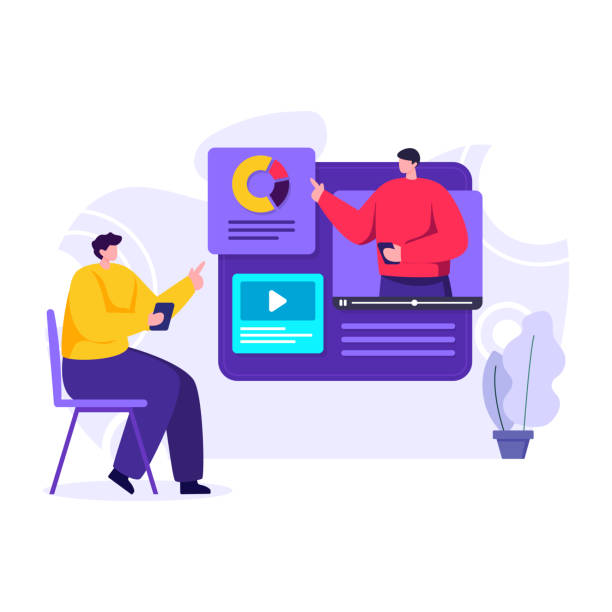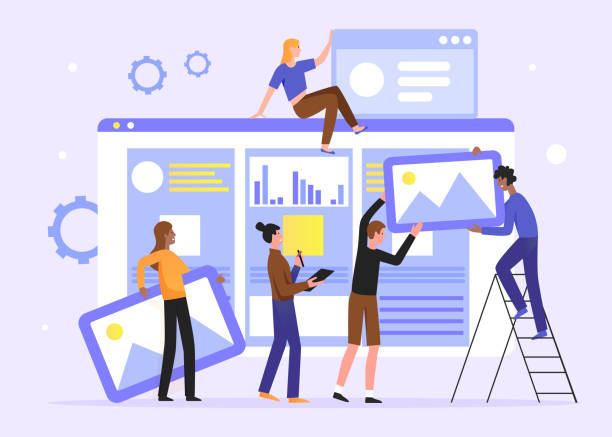Introduction to SEO-Optimized Website Design and Its Importance

In today’s digital world, having a website is just the first step.
What sets you apart from competitors and leads to online success is SEO-optimized website design.
This concept goes beyond mere visual appeal or technical performance; it means creating a website that is not only attractive and functional for users but also fully understandable and optimized for search engines like Google.
The importance of #SEO in website development is undeniable, as it helps you climb in #Google_rankings and attract more organic traffic.
This traffic, obtained through natural user searches, often has higher quality and increases the likelihood of converting visitors into customers.
Therefore, investing in SEO at the beginning of the design process means building a solid foundation for the long-term success of your #online_business.
A website with a search engine-optimized structure helps search engines better understand your content and present it to the right audience.
This process includes various aspects, from choosing appropriate keywords and producing valuable content to optimizing site loading speed and ensuring its compatibility with various devices (mobile and desktop).
Ignoring SEO during the design phase can lead to a lot of wasted time and resources in the future, as correcting fundamental SEO issues after launching the site will be much more difficult and costly.
As an explanatory and educational approach, it is essential to know that SEO principles must be woven into the fabric of your website design from the very beginning.
This proactive approach not only saves costs but also allows your website to start working at its full ranking potential from day one.
Suppose you have the best product or service, but your website isn’t visible in search results.
In that case, no one will know you exist.
SEO-optimized website design is the bridge that connects you to potential customers.
This is a smart investment that yields a significant return on investment in the long run.
By considering factors such as user experience (UX), internal link structure, image optimization, and the use of structured data, a website can not only be technically appealing to search engines but also provide an enjoyable and efficient experience for users.
This synergy between search engine requirements and user experience is the main key to success in search engine-optimized website design.
Ultimately, the main goal is for your website not only to be seen but also to attract high-quality traffic that literally helps your business grow.
This comprehensive and integrated approach is the foundation of every successful website in the digital age.
How much does losing business leads due to an unprofessional site cost you? Solve this problem forever with professional corporate website design by Rasawweb!
✅ Increase credibility and trust among potential customers
✅ Easier attraction of new business leads
⚡ Get a free consultation now!
Basic SEO Principles in Web Design
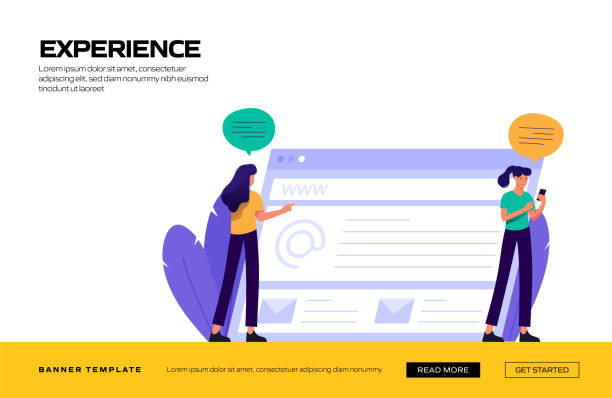
One of the most crucial steps in the process of SEO-optimized website design is understanding and implementing basic SEO principles from the very beginning.
These principles include a set of rules and best practices that help search engines crawl, index, and rank your website’s structure and content in the best possible way.
Among the most important of these principles is focusing on #mobile-first web design.
Given the significant increase in mobile phone usage for internet access, Google also places a strong emphasis on website mobile compatibility and even considers this factor as one of its ranking factors.
Therefore, ensuring that your website displays correctly on all types of devices and provides a seamless experience is crucial.
In addition to mobile-first, #site_speed is also a critical factor in SEO and #user_experience (UX).
Today’s users are impatient, and if your site loads slowly, they will quickly leave it.
Search engines also do not prefer slow sites.
Image optimization, caching, file compression (CSS, JS, HTML), and choosing a reliable hosting provider are among the actions that help increase site loading speed.
A positive user experience means easy navigation, attractive visual design, and quick access to the information the user needs.
If users can easily navigate your site and find what they are looking for, they will spend more time on your site, and their likelihood of returning increases, all of which are positive signals for search engines.
URL structure also plays an important role in SEO-optimized website design.
Short, descriptive URLs containing relevant keywords are more understandable for both users and search engines.
Additionally, creating an XML sitemap (sitemap.xml) and a robots.txt file is essential.
The sitemap helps search engines discover and index all important pages of your site, while robots.txt tells them which pages should not be crawled.
These items are the foundation of any successful SEO strategy and must be considered from the very first stages of planning and website optimization.
Without adhering to these fundamental principles, even the best content may never reach its true potential.
This section of our discussion is a specialized and educational guide for starting your SEO journey on your website.
Content Optimization for Search Engines

After ensuring the technical foundations of the website, it’s time for the most important part: content.
Content optimization is an integral part of any SEO-optimized website design.
Content is king, and search engines aim to provide the most relevant and high-quality content to their users.
The first step in this regard is extensive #keyword_research.
This helps you understand exactly what your target audience is looking for and what phrases they use to search.
There are numerous keyword research tools that help you discover keywords with high search volume and suitable competition.
Using these keywords in page titles, meta descriptions, headings (H1, H2, H3), and throughout the text signals to search engines what your content is about.
The meta description, displayed below the page title in search results, is an excellent opportunity to attract clicks.
It should be short, engaging, and contain the main #keywords.
Content quality is also of great importance; your content should be in-depth, informative, unique, and most importantly, valuable to users.
Search engines can detect and penalize low-quality or duplicate content.
This section is literally a specialized and guiding approach that requires careful attention to detail.
To better understand the keyword research process, we provide some important factors in keyword selection in the table below:
| Criterion | Explanation | Importance for SEO |
|---|---|---|
| Search Volume | The number of times a keyword is searched per month. | Indicates traffic potential. |
| Competition | The difficulty of ranking for that keyword. | The less, the better (usually). |
| Search Intent | The purpose behind the user’s search (informational, commercial, navigational). | Producing content aligned with the user’s intent. |
| Long-Tail Keywords | Longer and more specific phrases (usually with lower competition and higher conversion rates). | More precise audience targeting. |
Optimizing #quality_content goes beyond just keyword placement.
It includes logical content structure, using relevant images and videos, and internal linking to other pages on your site.
An SEO-optimized website design with strong content not only attracts traffic but also encourages users to spend more time on your site and interact with it, all of which are positive signals for search engines and help increase your site’s authority and ranking.
Page Load Speed and User Experience in SEO

In the discussion of SEO-optimized website design, page load speed and user experience (UX) are two inseparable factors that have a direct and significant impact on your site’s ranking in search engines.
Google has clearly stated that #page_speed, especially the #Core_Web_Vitals metric, is considered an important ranking factor.
Core Web Vitals include three main metrics: LCP (Largest Contentful Paint) which measures the loading time of the largest visual content on the page; FID (First Input Delay) which measures the browser’s response time to the first user interaction; and CLS (Cumulative Layout Shift) which checks the visual stability of the page.
Poor performance in any of these metrics can lead to a decrease in ranking and loss of visitors.
User experience (UX) is equally important.
When users land on your site, they should be able to navigate easily, find the content they are looking for, and enjoy the overall design of the site.
If your site is complex, slow, or visually cluttered, users will quickly leave it (increasing #bounce_rate).
This high bounce rate sends a negative signal to search engines, indicating that users are not satisfied with your site.
UX optimization includes factors such as logical navigation structure, responsive design for correct display on all devices, using readable fonts and appropriate colors, and presenting organized and scannable content.
This combination of speed and user experience provides an analytical and explanatory approach to improving SEO performance.
To improve loading speed and UX in search engine-optimized website design, actions such as optimizing image sizes (compressing and using next-generation formats like WebP), compressing codes (HTML, CSS, JavaScript), reducing HTTP requests, and using Content Delivery Networks (CDN) are essential.
CDN, by caching your site’s content on various servers worldwide, allows users to access content from the nearest server, significantly increasing loading speed.
Also, using appropriate plugins and tools to test site speed (such as Google PageSpeed Insights or GTmetrix) and analyze its performance helps you identify and resolve weaknesses.
Another important aspect of UX is Responsive Design, which ensures that your website is optimized and usable regardless of the user’s device screen size.
This is not only vital for user satisfaction but also essential for Google’s mobile-first SEO.
Ultimately, it should be remembered that the ultimate goal of any website design with strong SEO is to provide the best possible experience to users.
A site that loads quickly and is enjoyable to use not only keeps users satisfied but also naturally performs better in search results.
This comprehensive approach will guarantee the stability and growth of your online presence.
Are you losing potential customers due to an unprofessional website? Rasawweb is your answer! With our specialized corporate website design services:
✅ Enhance your business’s credibility and standing
✅ Experience attracting more targeted customers
⚡ Act now to get a free consultation!
Technical SEO for Ranking Stability
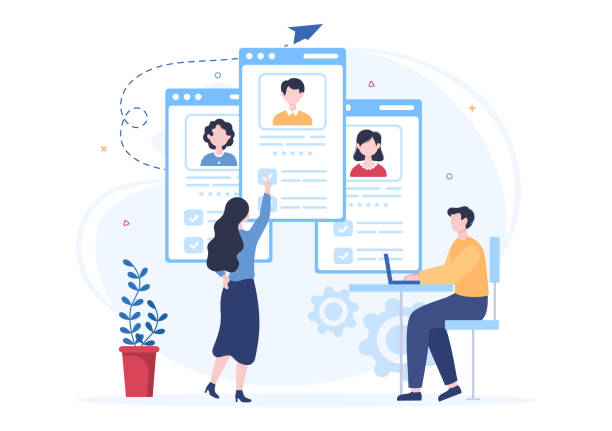
In the journey of SEO-optimized website design, technical SEO plays a vital role in ensuring your website’s proper #crawlability and #indexability by search engines.
This part of SEO addresses the technical aspects of the website that directly affect search engines’ ability to access, crawl, interpret, and index your site.
Without strong technical SEO, even the best content or most beautiful design may never reach its full potential.
One of the first steps in technical SEO is ensuring site accessibility for search engine crawlers.
This includes reviewing the robots.txt file, which tells search engines which parts of your site should be crawled and which should not.
Furthermore, having an up-to-date and correct #XML_sitemap (sitemap.xml) acts like a roadmap for search engines.
This file helps them discover and index all important pages of your site, especially pages that might be less accessible via internal links.
For a search engine-optimized website, URL structure is also important; semantic and readable URLs are better for users as well as for search engines.
Using Canonical Tags is vital to prevent duplicate content issues.
These tags show search engines which version of a page is the original and authoritative one, preventing the indexing of multiple versions of the same content, which can harm your ranking.
This section covers the specialized and educational aspects of SEO.
Another important aspect of technical SEO is the implementation of Structured Data or Schema Markup.
These codes help search engines better understand your site’s content and display specific information such as user reviews, product prices, addresses, or events more prominently in search results (Rich Snippets), which can increase the click-through rate (CTR).
Checking and fixing 404 errors and 301/302 redirects is also of high importance.
404 errors disrupt user experience and send negative signals to search engines, while correct redirects help preserve link equity and transfer it to new pages.
Website security (HTTPS) is now also a ranking factor.
Ensuring that your website uses an SSL certificate not only keeps user data secure but also gains the trust of search engines and users.
Each of these technical SEO elements fits together like a puzzle to create an SEO-optimized and sustainable website design that can maintain and improve its ranking over time.
Ignoring any of these aspects can lead to hidden problems that ultimately negatively affect your website’s visibility in search results.
The Role of Content Marketing in SEO
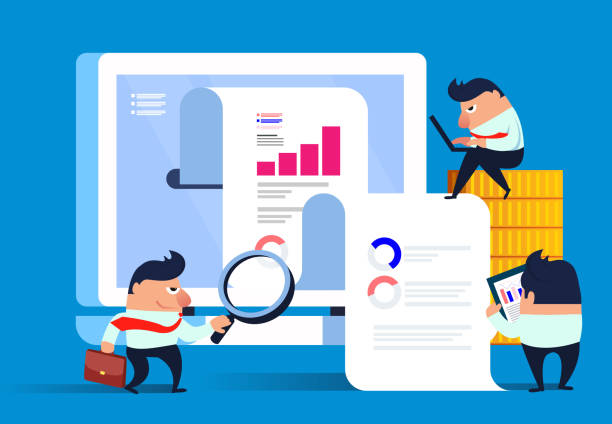
In the process of SEO-optimized website design, content plays a central role, and content marketing is the strategy that transforms this content into a powerful tool for attracting and retaining audiences.
Content marketing not only helps attract traffic from search engines but also leads to building credibility and trust among the audience.
A strong content strategy involves the continuous production of #fresh, relevant, and high-quality content that answers user questions and meets their needs.
This content can be in the form of blog posts, specialized articles, videos, infographics, or even podcasts.
The main goal is for your website to become a reliable and #authoritative source in its field.
For search engines, websites that regularly publish new and valuable content are considered dynamic and active and often receive higher rankings.
This is especially vital for your SEO and website optimization.
Using the Pillar Page and Content Clusters model is an effective method in content marketing.
A pillar page is comprehensive, in-depth content about a broad topic that connects via internal links to a set of more detailed articles (content clusters) related to that topic.
This structure not only helps users easily find relevant information but also assists search engines in better understanding the main topics of the site and the relationships between them.
This section, as an explanatory and news-oriented content, helps you become familiar with the latest approaches in content marketing.
Successful content marketing also involves promoting content across various channels.
After content creation, sharing it on social media, sending email newsletters, and even using paid advertising can help increase reach and attract more visitors.
The more your content is seen and receives engagement, the more likely it is to acquire positive SEO signals such as backlinks and social shares.
These interactions not only directly help improve rankings but also increase your domain authority.
Ultimately, implementing a strong #content_marketing strategy alongside SEO-optimized website design is a winning combination.
Great content attracts users, keeps them engaged, and provides them value, while SEO ensures that this content is properly delivered to the target audience.
This synergy between content and SEO is the main key to building a sustainable and successful online presence that not only attracts high traffic but also converts this traffic into loyal customers.
Link Building and Domain Authority

One of the main pillars of any SEO-optimized website design and successful SEO strategy is Link Building.
Links, especially backlinks (links from other sites to your site), act like a vote of confidence for your website.
The greater the number and quality of incoming backlinks to your site, the more credible and authoritative search engines will consider your site, and this directly impacts your #Domain_Authority.
Of course, not every link is valuable; quality takes precedence over quantity.
Links from reputable websites relevant to your field of work have much higher value than spammy or irrelevant links.
In addition to backlinks, internal linking is also of high importance.
Internal links help you distribute the authority of different pages on your site equally and assist search engines in better crawling the site and understanding the thematic connection between different pages.
This also improves user experience, as users can easily navigate from one page to another related page and gain more information.
Internal linking also allows you to highlight your more important pages with more links.
These aspects offer a specialized and educational approach to the topic of SEO.
Types of backlinks include dofollow (which pass SEO authority) and nofollow (which do not pass SEO authority but can still attract traffic).
The focus should be on acquiring high-quality dofollow backlinks from authoritative sources.
Link-building strategies must be ethical (White Hat SEO), as Google penalizes websites that use spammy methods for link building.
| Link Building Strategy | Explanation | SEO Benefit |
|---|---|---|
| High-Quality Content Creation | Creating content that is worth linking to. | Attracting natural and high-quality links. |
| Outreach | Contacting other websites to request a link. | Acquiring links from authoritative sources. |
| Broken Link Building | Finding broken links on other sites and suggesting your content. | A good opportunity to gain backlinks. |
| Guest Posting | Writing articles for other blogs and placing a link to your site. | Increased visibility and link acquisition. |
In an SEO-optimized website design, link building is an ongoing process, not a one-time task.
Over time, with continuous effort in producing valuable content and building relationships, your domain authority will increase, helping you achieve higher rankings in search results.
This increased authority means that search engines trust your content more and present it as a credible source to their users.
SEO Performance Review and Analysis
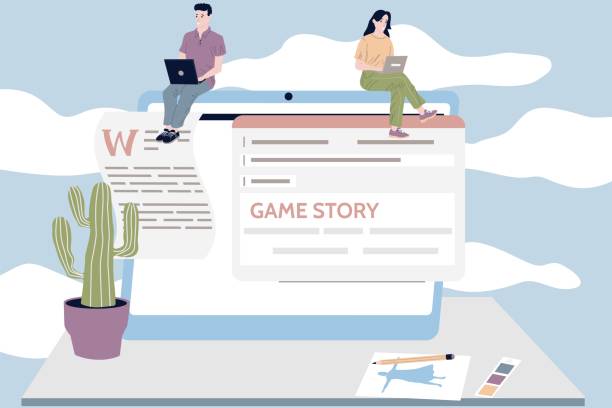
After implementing the principles of SEO-optimized website design and content and link-building strategies, the next crucial step is SEO performance review and analysis.
SEO is not a static process; rather, it is a dynamic and continuous process that requires constant monitoring, analysis, and optimization.
For this purpose, various tools are available to help you monitor your website’s performance in search engines and identify strengths and weaknesses.
Among the most important of these tools are Google Analytics and Google Search Console.
Google Analytics provides you with precise information about website traffic, user behavior (such as bounce rate, pages visited, time spent on site), and traffic sources.
In contrast, Google Search Console offers direct insights into how Google interacts with your site.
This tool helps you view technical issues (such as crawl errors), keywords you’ve ranked for, click-through rate (CTR) in search results, and incoming backlinks.
Furthermore, it allows you to submit your sitemaps and request re-indexing of pages.
Monitoring these #KPIs (Key Performance Indicators) helps you understand which SEO strategies have been effective and which need optimization.
This section of the content brings you an analytical and guiding approach.
Beyond these main tools, there are also paid SEO tools like Ahrefs, Semrush, and Moz, which offer more advanced capabilities such as competitor analysis, in-depth keyword research, and rank tracking.
Using these tools, you can track your keyword performance, observe changes in page rankings, and discover new backlinks.
Regular analysis of this data helps you continuously adjust and improve your SEO strategy.
For example, if you notice that a particular page is not ranking well, you can improve its content, add more internal links to it, or acquire new backlinks for it.
SEO-optimized website design is not a one-time task but an iterative process.
With every Google algorithm update, change in user behavior, or entry of new competitors, you may need to revisit your SEO strategy.
Data analysis allows you to identify these changes in time and react appropriately.
By relying on real data and actionable insights, you can make more optimal decisions to improve your site’s SEO performance and ensure your website is always on the path to online success.
This continuous cycle of implementation, monitoring, and optimization guarantees the sustainability and growth of your presence in the digital world.
Are you worried about your e-commerce site’s low conversion rate and not achieving your desired sales?
Rasawweb is your specialized solution for having a successful e-commerce site.
✅ Significant increase in conversion rate and sales
✅ Professional and user-friendly design to satisfy customers
⚡ Ready for an online sales transformation? Get a free consultation!
Challenges and Future Trends in SEO
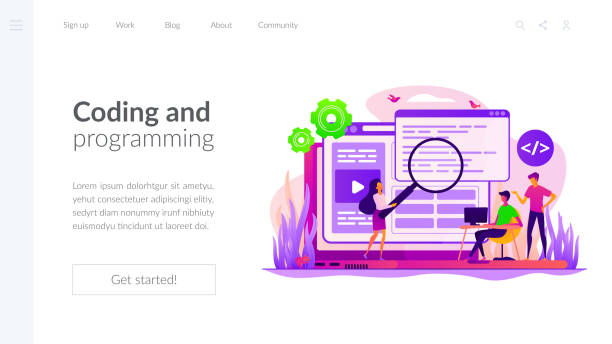
The world of SEO is constantly evolving, and an SEO-optimized website design must be prepared to face future challenges and trends.
One of the most important and growing trends is the role of #AI_in_SEO and machine learning algorithms.
Google is increasingly using AI to better understand content and user search intent.
This means that simply stuffing text with keywords is no longer enough; content must truly be valuable, comprehensive, and responsive to complex user needs.
Algorithms like RankBrain and BERT (and now MUM) indicate Google’s move towards a deeper semantic understanding and relationships between concepts.
Another important trend is the growing popularity of #voice_search.
With the spread of voice assistants like Siri, Google Assistant, and Alexa, users are increasingly using conversational queries for search.
This has a direct impact on keyword strategy, shifting towards longer phrases (long-tail keywords) and more natural language.
For SEO and website optimization, this means optimizing content to answer direct and conversational questions, not just single keywords.
This section of our content is a thought-provoking and news-oriented content that addresses the future of SEO.
The concept of E-A-T (Expertise, Authoritativeness, Trustworthiness), introduced by Google, has become increasingly important.
This is especially vital for websites operating in health, finance, or legal fields (Your Money Your Life – YMYL).
Google wants to ensure that the information it provides comes from credible and expert sources.
Therefore, in website design with strong SEO, highlighting the expertise, credentials, and credibility of authors and content sources is of high importance.
This includes displaying author information, linking to credible profiles, and collecting customer reviews and testimonials.
SEO sustainability in the future requires embracing changes and the ability to adapt quickly.
#Google_Algorithm_Updates are an ongoing event that requires continuous monitoring and appropriate reaction.
Websites must be flexible to adapt to these changes.
Also, the importance of user experience (UX) continues to grow, and search engines are increasingly focusing on signals related to user interaction with the website.
Ultimately, SEO-optimized website design in the future will increasingly focus on producing valuable content, providing an unparalleled user experience, and demonstrating expertise and credibility to search engines and users.
Preparing for these challenges and future trends is key to maintaining competitiveness in the online space.
Summary and Next Steps in SEO-Optimized Website Design
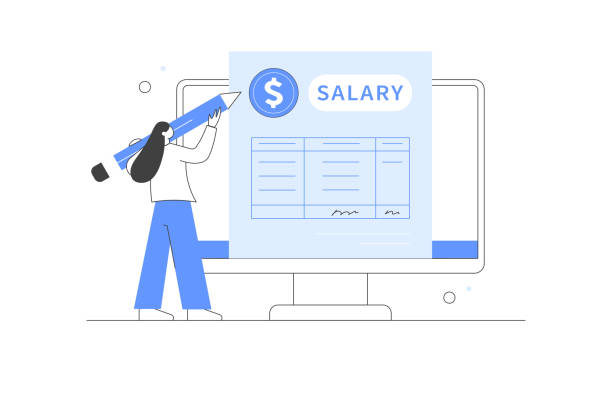
Throughout this article, we discussed the various complex dimensions of SEO-optimized website design and emphasized its fundamental importance for success in today’s digital world.
From basic technical SEO principles to content optimization, page load speed, user experience, link building, and performance analysis, each plays a vital role in the larger puzzle of online visibility.
Now that we have reached the end of this informative and engaging journey, it’s time to summarize our learnings and think about the next steps.
The most important thing to remember is that SEO is a dynamic and continuous process, not a one-time project.
The web world is constantly changing, and to maintain your position in search results, you must always be #continuously_learning and adapting.
Your next step after understanding these concepts should be to formulate a comprehensive and actionable #SEO_strategy.
This strategy should include keyword research, content planning, technical site review and optimization, and a link-building strategy.
Regularly review your website’s performance using tools like Google Analytics and Search Console to identify strengths and weaknesses and make data-driven decisions.
Never overlook the importance of user experience; a site that is enjoyable and easy for users will naturally perform better in SEO and ultimately contribute to your #online_success.
Also, remember that Patience is a virtue.
SEO results typically don’t happen overnight.
Improving rankings and increasing organic traffic requires time, effort, and persistence.
But the reward – high-quality traffic, increased customers, and business growth – is definitely worth the investment.
Learn from your competitors, but don’t imitate them.
Look for your unique strengths and use them to differentiate your website.
Ultimately, remember that the final goal of any SEO-optimized website design is to better serve users.
The more you can answer users’ questions, solve their problems, and provide an unparalleled experience, the more guaranteed your success will be in search engines and in the business arena.
This journey towards continuous optimization is an exciting and knowledge-rich journey.
With a smart approach and tireless effort, you can transform your website into a powerful tool for achieving your goals.
Frequently Asked Questions
| Question | Answer |
|---|---|
| What does SEO-optimized website design mean? | Designing a website that, in addition to an attractive appearance, is technically and content-wise optimized to achieve higher rankings in search engine results. |
| Why is SEO-optimized website design important? | It increases organic traffic through search engines, improves business visibility, attracts more customers, and ultimately boosts sales. |
| What are the key elements in SEO-optimized website design? | Mobile optimization, high loading speed, quality and relevant content, correct keyword usage, proper URL structure, and using title and meta tags. |
| What role does content play in website SEO? | Unique, valuable, informative, and keyword-targeted content plays a vital role in attracting users and achieving better rankings in search results. |
| What is Mobile-First Indexing? | A Google approach where the mobile version of a website is prioritized for indexing and ranking. Therefore, website responsiveness for mobile is essential. |
| How can website loading speed be improved? | Compressing images, using caching, optimizing CSS and JavaScript codes, using a strong hosting provider, and enabling Gzip compression. |
| What is the importance of keywords in SEO? | Keywords help search engines understand the topic of your page and link it to relevant user searches. |
| What role do Title Tag and Meta Description play? | The title tag is the most important element in on-page SEO, and the meta description is a summary of the page’s content that encourages users to click. Both are displayed in search results. |
| How does Internal Linking help SEO? | It helps search engines discover and index different pages of the site and distributes page value across various sections of the site. It also improves user experience. |
| What is the use of a Sitemap in SEO? | It is an XML file that provides a list of all important pages of a site to search engines to facilitate site crawling and indexing. |
And other services of RasaWeb advertising agency in the field of advertising
Smart UI/UX: Professional optimization for digital branding using key page optimization.
Smart Sales Automation: Professional optimization for online growth using user experience customization.
Smart Conversion Rate Optimization: An effective tool for digital branding with the help of custom programming.
Smart Advertorials: An innovative platform for improving customer acquisition with marketing automation.
Smart Customer Journey Mapping: Designed for businesses looking to increase website traffic through user experience customization.
And over hundreds of other services in the field of internet advertising, advertising consulting, and organizational solutions
Internet Advertising | Advertising Strategy | Advertorials
Resources
SEO Optimization Guide
Key Website Design Tips
Online Marketing Strategies
Technical SEO Checklist
? Rasawweb Afarin, by providing comprehensive digital marketing services including SEO-optimized website design and targeted strategies, puts your business on the path to online growth and success.
📍 Tehran, Mirdamad Street, next to Central Bank, Southern Kazerun Alley, Ramin Alley No. 6

